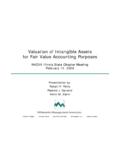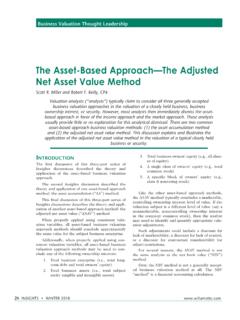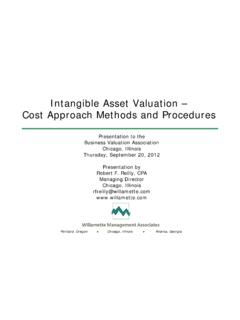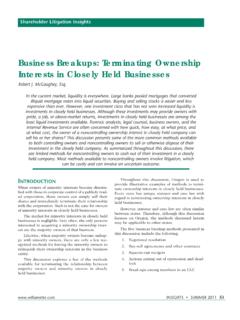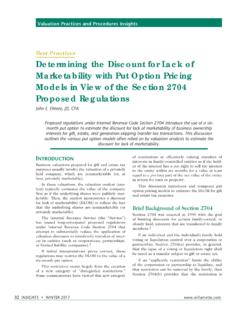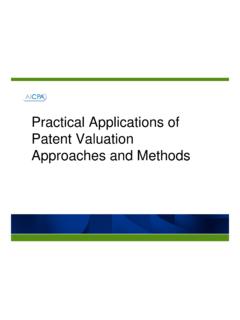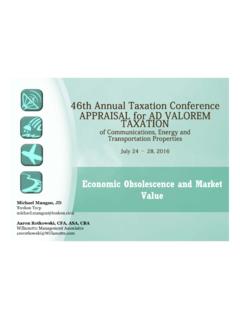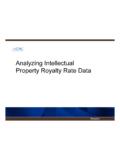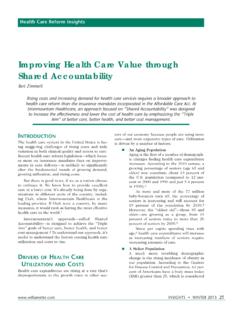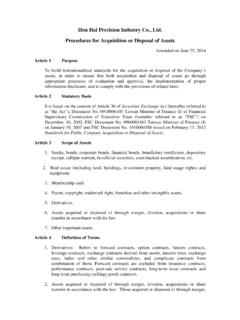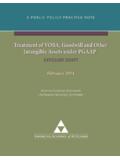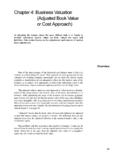Transcription of NAPTR-TEC Intangible Asset Valuation Cost …
1 Portland, Oregon Chicago, Illinois Atlanta, GeorgiaIntangible Asset Valuation : Cost approach Valuation methods and ProceduresRobert F. Reilly, CPAW illamette Management Association of Property Tax Representatives Transportation Energy CommunicationsDallas, Texas, October 21, 2014 Willamette Management Associates1 Discussion Outline What is and what is not an Intangible Asset Examples of Intangible assets and intellectual property Common reasons to value Intangible assets Intangible Asset Valuation approaches and methods Intangible Asset cost approach considerations Intangible Asset cost approach methods and procedures Cost approach illustrative example Valuation report considerationsWillamette Management Associates2 What is an Intangible Asset ? An Intangible Asset should be: Intangible ; that is, it lacks physical substance, so its value comes from its bundle of legal rights an Asset ; so it should have certain ownership characteristics:1.
2 It is subject to a specific identification and a recognizable description2. It is subject to legal existence and legal protection3. It is subject to the rights of private ownership, and that private ownership should be transferable4. It is documented by some tangible evidence or manifestation of its existence (for example, a contract, a license, a registration document, a compact disc, a listing of customers, or a set of financial statements)5. It is created or comes into existence at an identifiable time or as the result of an identifiable event6. It is subject to being destroyed or to a termination of existence at an identifiable time or as the result of an identifiable eventWillamette Management AssociatesIdentifiable Intangible AssetsASC Topic 804 Recognition Considerations FASB ASC 805-30-20 Glossary:Identifiable Intangible AssetsThe acquirer recognizes separately from goodwill the identifiable Intangible assets acquired in a business combination.
3 An Intangible Asset is identifiable if it meets either (1) the separability criterion or (2) the contractual-legal criterion described in the definition of Management AssociatesIdentifiable Intangible AssetsASC Topic 805 Recognition Considerations FASB ASC 806-30-20 Glossary:IdentifiableAn Asset is identifiable if it meets either of the following criteria:1. It is separable, that is, capable of being separated or divided from the entity and sold, transferred, licensed, rented, or exchanged, either individually or together with a related contract, identifiable assets, or liability, regardless of whether the entity intends to do It arises from contractual or other legal rights, regardless of whether those rights are transferable or separable from the entity or from other rights and AssetsAssets (not including financial assets) that lack physical substance.
4 (The term Intangible assets refers to Intangible assets other than goodwill.)4 Willamette Management Associates5 What is Not an Intangible Asset ? There are Intangible attributes or influences that may affect the value of Intangible assets These attributes or influences are not assets Examples include:1. High market share2. High profitability or high profit margin3. Lack of regulation4. A regulated (or protected) position5. Monopoly position (or barriers to entry)6. Market potential7. Breadth of customer appeal8. Mystique9. prices (or full prices) to confidence or growth return on of Management Associates6 Examples of Intangible Assets: ASC 805 Marketing-related Intangible assets Trademarks, trade names, service marks, collective marks, certification marks Trade dress (unique color, shape, package design) Newspaper mastheads Internet domain names Noncompetition agreements Customer-related Intangible assets Customer lists Order or production backlog Customer contracts and related customer relationships Noncontractual customer relationshipsWillamette Management Associates7 Examples of Intangible Assets: ASC 805 (cont.)
5 Artistic-related Intangible assets Plays, operas, and ballets Books, magazines, newspapers, and other literary works Musical works such as compositions, song lyrics, and advertising jingles Pictures and photographs Video and audiovisual material, including motion pictures or films, music videos, and television programsWillamette Management Associates8 Examples of Intangible Assets: ASC 805 (cont.) Contract-based Intangible assets Licensing, royalty, and standstill agreements Advertising, construction, management, and service or supply contracts Lease agreements (whether the acquiree is the lessee or the lessor) Construction permits Franchise agreements Operating and broadcast rights Servicing contracts such as mortgage servicing contracts Employment contracts Use rights such as drilling, water, air, timber cutting, and route authoritiesWillamette Management Associates9 Examples of Intangible Assets: ASC 805 (cont.)
6 Technology-based Intangible assets Patented technology Computer software and mask works Unpatented technology Databases, including title plants Trade secrets, such as secret formulas, processes, and recipesWillamette Management Associates10 Examples of Intangible Assets: IRC 197 Internal Revenue Code Section 197 Intangible assets include: Goodwill Going concern value Any of the following Intangible items: workforce in place including its composition and terms and conditions (contractual or otherwise) of its employment, business books and records, operating systems, or any other information base (including lists or other information with respect to current or prospective customers), any patent, copyright, formula, process, design, pattern, knowhow, format, or other similar item, any customer-based Intangible , any supplier-based Intangible , and any other similar item.
7 Any license, permit, or other right granted by a governmental unit or an agency or instrumentality thereofWillamette Management Associates11 Examples of Intangible Assets: IRC 197 (cont.) Internal Revenue Code Section 197 Intangible assets include: (cont.) Any covenant not to compete (or other arrangement to the extent such arrangement has substantially the same effect as a covenant not t o compete) entered into in connection with an acquisition (directly or indirectly) of an interest in a trade or business or substantial portion thereof Any franchise, trademark, or trade nameWillamette Management AssociatesIntellectual Property Intellectual property assets represent a small subset of general Intangible assets Intellectual property includes the following four Intangible assets only.
8 Patents Copyrights Trademarks Trade secrets12 Willamette Management Associates13 Categories of Reasons to Value Intangible Assets Transaction pricing and structuring Financing securitization and collateralization Federal and state tax planning and compliance Management information and strategic planning Bankruptcy and reorganization Forensic analysis and dispute resolution Intercompany use and ownership transfers Financial accounting and fair value reporting Corporate governance and regulatory compliance License, joint venture, development opportunitiesWillamette Management Associates14 Intangible Asset Valuation Considerations What Intangible Asset is the Valuation subject? What Intangible Asset rights are included in the Valuation ? What is the appropriate standard of value?
9 What is the appropriate premise of value? What is the appropriate Valuation date(s)? Who is the intended audience for the Valuation ? What is the appropriate type of report?Willamette Management Associates15 Generally Accepted Intangible AssetValuation Approaches and methods Cost approach methods Reproduction cost new less depreciation method Replacement cost new less depreciation method Trended historical cost less depreciation method Market approach methods Relief from royalty method Comparable uncontrolled transactions method Comparable profit margin method Income approach methods Differential income (with/without) method Incremental income method Profit split method (or residual profit split method) Residual (excess) income method)Willamette Management AssociatesReasons to Use the Cost approach The selection of the applicable Valuation approaches is a process of elimination.
10 If there are sufficient reliable data, then the analyst will typically apply all three Valuation approaches. If there are insufficient guideline sale or license transaction data available, then the analyst may have to rely on the cost approach by default. If the Intangible Asset is not the type of Asset that generates a measurable amount of income (however defined), then the analyst may have to rely on the cost approach by Management AssociatesApplication of the Cost approach Certain Intangible assets particularly lend themselves to the cost approach , such as:1. recently developed ( , relatively new) Intangible assets2. Intangible assets for which the historical development cost data are still available3. Intangible assets that are operated by an owner with the expertise to assist the analyst in the estimation of a current development cost4.
